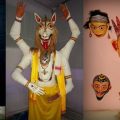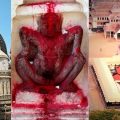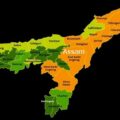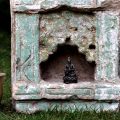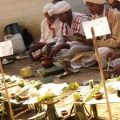Ankiya-Nat and Bhaona Traditions of Assam – A Living Cultural Heritage of Sanatan Dharm
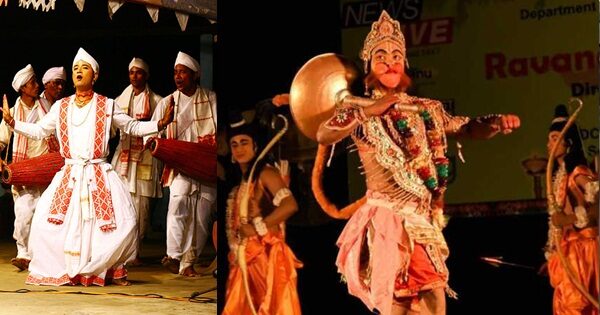
Performing arts of various kinds occupied a fairly exalted position in the ancient land of Pragjyotishpur and Ma Kamakhya. E.g. one of the earliest pieces of evidence in this regard comes from Palakapyamuni, author of the famous treatise on elephant lore called Hasti-ayurveda written in the 5th century B.C., who belonged to the region of the Lauhitya or present-day Brahmaputra Valley of Assam. The sage writes that close to his father’s ashrama was that of Bhargavamuni’s, which used to continuously reverberate with the chanting of Vedic hymns and mantras.
The name Pragjyotishpur also finds mention in Bharatmuni’s Natyashastra, which talks about four different pravrtis (local usages) of drama – daksinatya, avanti, pancala-madhyama, and odra-magadh – in different regions of India. Of these, the last one was prevalent in the eastern region, which included Anga, Vanga, Kalinga, Odra, Magadha, Nepal, and Pragjyotishpur. Another important source of information in this regard is the Kalikapurana associated with the Tantric Sakti tradition of Sanatan Dharm. It was written in the region of Kamarupa during the 10th-11th century and contains various references to singing and dancing.
The extreme violence and brutality associated with the Islamic invasions shook the foundations of the age-old Vedic civilisation and its associated beliefs, practices and rituals, especially idol worship. The abhorrence of the blood-thirsty invaders towards idol worship led to the massive destruction of Mandirs and the idols housed inside their garbhagrihas throughout the country, and Hindus were labelled as kafirs (non-believers). The destruction of a Mandir did not just signify the destruction of a building and a gem of an architecture; with its idol being razed to the ground, it signalled the beginning of the end of an entire belief system of invaluable traditions and a cultural heritage kept alive by its followers through numerous rites and rituals of which the temple constituted an inalienable part.
Such inhuman savagery impelled the thinkers and reformers of Hindu society to evolve a much simpler and liberal faith that could be easily practised by all within the comfort zones of their own homes, without inviting the ire of the barbaric invaders. It was in this context that the Vaishnava-Bhakti movement (12th-15th centuries A.D.) was started by the Alvar and the Nayannar saints of South India, from where it spread to the northern and eastern regions of the country. It propounded that divine grace could be achieved by people of all castes and classes merely through faith and devotion (bhakti), thereby doing away with excessive outward religious ritualism. It was towards the latter half of the 15th century that the Vaishnavite movement in Assam was initiated by Srimanta Sankardeva, based on the philosophy of Mahapurusiya Dharma or Ekasarana Naam-Dharma. It stresses upon the recitation of naam (name) of the Supreme Deity, i.e. Vishnu, in prayers.
A very important and significant factor behind the extensive spread of the Vaishnavite movement in Assam under the leadership of Srimanta Sankardeva was the role of literary compositions and dramatic performances that attracted more and more people into its fold in due course of time. This was indeed a notable feature of the Vaishnavite movement in Assam that made optimum use of diverse creative and artistic media – literature, music, dance, drama, painting, sculpture, architecture, etc. – and made them an integral part of the new faith and its order.
With the dark pall of Islamic invasions looming large, it ushered in an era of a fresh socio-cultural renaissance that gradually led to the development of an entirely new genre of philosophy, art, music and dance-dramas. It eventually came to be manifested in the form of Borgeets (devotional songs dedicated to Narayana/Vishnu), Ankiya-Nats and Bhaonas, which acted as different media for the dissemination of the teachings of Sankardeva. The evolution of Sattriya-Nritya – one of the eight principal classical dance forms of India recognised by the Sangeet Natak Akademi – has been traced to the Ankiya Bhaona tradition of Assam. No wonder, some of the finest treasures-troves of Assamese art and culture owe their origins to the Vaishnava legacy of Srimanta Sankardeva.
The plays composed by Srimanta Sankardeva are popularly known as Ankiya-Nats or Anka-Nats – Ankiya meaning one, and Nat meaning drama. It is a traditional and ritualistic theatre form of Assam that became immensely popular under the pioneering efforts of Sankardeva and his foremost disciple Madhavdeva, with the idea of preserving the fundamental principles of Dharma as enshrined in our sacred texts such as the Mahabharata, Ramayana, and Puranas. The enactment of these plays in a distinctive style and note, including those plays which were composed in the later years by Sankardeva’s followers, is known as Bhaona.
However, it may be mentioned here that the term Ankiya-Nat is used to refer to the plays of only Srimanta Sankardeva, such as Koliya-damana, Rukminiharan, Parijatharan, Keli-gopala, Patni-prasada, Ramvijaya, etc. Of the many plays ascribed to Madhavdeva, one – Arjunbhanjana – is in the full-fledged format of an Ankiya-Nat, while all the other plays or playlets written by him belong to the sub-class called Jhumura. Krishna, the eighth avatar of Vishnu, is the chief character of these plays while the leading female characters include Rukmini, Satyabhama, Sita, and Yashoda.
The Bhaona begins with a prelude/preliminary commonly known as dhemali in Assamese. There are said to be twelve different types of preliminaries called dhemalis. One of its outstanding features is the Gayan-Bayan (Gayan meaning singers, and Bayan meaning musicians). It is a highly rhythmic orchestral musical performance centred around the playing of two popular musical instruments from Assam – the khol (a big drum with a unique acoustic property) and the bhortal (huge cymbals). The movement of the hands and feet of the singers and the musicians both, is determined by the tempo of the khol.
After the dhemali, the sutradhara (compere) introduces the drama but only after his preliminary dance performance called the sutradhari nac is over. The sutradhari nac, often presented independently, forms a major part of the Bhaona performance. In the course of the sutradhari nac, the sutradhar recites a verse called the nandi while at the same time, narrating the story of the play and also introducing its characters by reciting different shlokas and bhatimas (Assamese devotional songs dedicated to Vishnu) to the audience. In this way, he also establishes a close rapport with members of the audience. He then provides directions for the Bhaona to begin.
Normally dressed in white, the sutradhar takes his position behind a curtain called ar-kapor. Often, there is an arch with lighted earthen lamps called agnigarh. When the curtain is raised, the sutradhar is seen in a kneeling position as if in obeisance. He slowly rises and begins the dance movements in a series of stages that are in consonance with the music provided by the orchestra of the Gayan-Bayan. The different characters of a Bhaona also make their entry through different dance movements called pravesar nac, the chief among them being Krisna pravesar nac, or Krisna nac, or gosai pravesar nac, distinctive for its gait and subtleness.
Similarly, the dance of the entry of the gopis is called gopi pravesar nac, which has a beautiful feminine grace about it. Characters such as rishis, clowns, demons and villains also have their own poses or bhangis for making entry and exit to and from the stage. Battle scenes are executed in stylised dance patterns called yuddhdar nac or ‘dance of the battle’. Rasar nac is a dramatic representation of the Rasa episode of the Bhagavata, originally based on the plays on that theme written by Sankardeva (Keligopala) and Madhavdeva (Rasajhumura).
It may be mentioned here that a particular class of song compositions akin to the Borgeet system is represented by the raga-based songs that form parts of the Ankiya-Nats. These are popularly known as Ankiya-Geet or Ankar-Geet chiefly because of their close association with the Ankiya-Nats. These songs are marked out by the fact that each of them has to be sung in the particular tala that has been specified for it in the play, while a Borgeet proper can be rendered in any tala or a combination of talas. The rendering of a Borgeet commonly starts with a rag-diya or rag-tana, which is the anibaddha part and is akin to alapa. Syllables like ha, ri, ta, na, and invocations of Hari, Ram, Govinda, or ‘Krisna-Sankara-Guru-Ram’ are used in the rag-diya part. The song itself proceeds through its rendering in some time-beat that has different parts like ga-man, ghat, and cok. The only accompanying instruments are the khol and the bhortal.
Actors who take part in a Bhaona performance are called Bhawariya, or the one who produces bhava/emotion in the minds of the spectators. The dancers are known as Natuwa. Before the Bhaona is being publicly staged, both the Bhawariyas and the Natuwas are immaculately trained in their roles by an expert of the Sattriya cuture and traditions. In most of his literary and dramatic compositions, Sankardeva had used the Assamese language as it was spoken during that period of time, such that it could be read and understood by any ordinary person. In order to render a dramatic effect to most of his songs and dramas, Sankardeva used Brajavali which was a mixture of Maithili as spoken in rural Bihar and Assamese. However, the dialogues that were originally used by Sankardeva in the lyrical form of Brajavali in most of his plays, have now been replaced by the spoken Assamese language in the Bhaona performances.
It needs to be mentioned here that an entire handicrafts-based cottage industry has sprung up in several villages of Assam so as to cater to the demands and needs of the Bhaona troupes of artistes, dancers and musicians. There is a separate class of weavers and artisans called khanikars in the villages, who are specialists in the manufacture of decorative costumes and traditional Assamese accessories and ornaments adorned with local, folk designs, which exclusively cater to the cast and crew of the Bhaona.
The khanikars are also professional sculptors who are well-trained in diverse vocations ranging from wood-carving, cane and bamboo works to mask-making for Bhaonas, and illustration of manuscripts. This has also led to the formation of various self-help groups and small-scale industries such as weaving units in the villages, centring around these traditional art and craft forms. As a result, a system of banking and micro-financing has emerged at the village level in Assam in order to cater to these local industries.
For use in the Bhaona performances, a few Sattras in Assam such as the Samaguri Sattra in Majuli and the Khatpar Sattra in Sivasagar district of Upper Assam, are well-known for the manufacture of masks called mukha. Popularly known as mukha-xilpo, the art of mask-making forms an integral part of any Bhaona performance. These masks are made from either animal skin or cloth over bamboo/cane structures or any other mechanical devices which are used as a means of support. The distinctive characteristic feature that particularly stands out in these masks is that they are generally manufactured from a local variety of woven bamboo splits called jatibanh, covered with a layer of cotton cloth and clay, so that they remain light in comparison to their size. The morphological features of these masks that are made to suit different characters in the play are inspired from natural forms. The masks possess both human features and animal features.
There is a spiritual and sacred aspect associated with these masks. Before the beginning of the Bhaona, the masks that would be donned by the different characters (both human and animal) are being taken to the manikut (sanctum-sanctorum) of the Namghar (prayer hall of the Assamese Hindus). Here, they are paid obeisance by the lighting of an earthen lamp, along with the burning of incense powder and incense sticks while the khol and the bhortal play in the background. This is accompanied by the singing of naam in devotion to Vishnu. After the Bhaona is over, these masks are carefully kept in a clean place in the Namghar itself, where earthen lamps are being lit and incense sticks burnt everyday after sunset in front of these.
Bhaonas are a regular feature during ceremonial occasions such as Janmashtami, Maaghi-Purnima, etc. They also often take place on full-moon nights, before the beginning of the annual harvest season, or after harvesting of the crops when the villagers remain free from the burden of agricultural work for sometime. Bhaona performances mostly begin in the evening and continue throughout the night. Depending upon the length of the play, sometimes they also start in the afternoon and continue well till late into the night. E.g. plays such as Madhavdeva’s Cordhara, Pimpara, Gucuwa, etc. are of a comparatively shorter duration and end before nightfall. Bhaonas are not supposed to take place in the wee hours of the morning or in broad daylight.
Bhaonas play an important role in spreading the message of solidarity, coherence and the spirit of goodwill and cooperation among people. Since they make use of both sound and visual elements very prominently, Bhaonas have an intense communication potential to strike a chord of familiarity with the audience that helps them differentiate between Dharma and Adharma. Traditional themes of the plays are rendered a contemporary relevance with respect to the actions and deeds of morality versus immorality, courage and cowardice, etc. committed by the human or demigod characters in the Bhaonas. This makes the performance a very powerful and effective audio-visual medium of acquainting people with not only the different aspects of religion, but also the spiritual and ethical dimensions of life and living in harmony with the universe.
The Axom Sattra Mahasabha – parent body of all the Sattras and Namghars of Assam – has been at the forefront of organising a Bhaona festival called Setubandha periodically since 2003. Literally meaning “Building Bridges”, Setubandha is aimed at achieving social and cultural integration of the diverse tribes and ethnic groups and communities across the state of Assam. Hence, one of the outstanding features of Setubandha is the equal participation of people belonging to different janajati communities of Assam such as Mising, Sonowal, Kachari, Bodo, Karbi and other tea-garden communities spread across different geographical regions of the state. They are selected and imparted training by members of the Axom Sattra Mahasabha itself.
Since their emergence, both Ankiya-Nats and Bhaonas have undergone a vigorous process of fusion, expansion and evolution, leading to the development of a range of musical genres within the Vaishnavite parampara of Assam. Most of them are practised fairly widely and vigorously even today at different levels, both ritualistically and as art forms. E.g. musical recital of the Kirtan-Ghosha by Srimanta Sankardeva, the Naam-Ghosha by Madhavdeva, and other sacred texts, different types of naam-prasanga (congregational singing of naam dedicated to Vishnu), etc. The position of extraordinary importance occupied by Ankiya-Nat and Bhaona in the context of the development of medieval dance and drama traditions has been recognised and highlighted by experts like Kapila Vatsyayan too, who speaks in glowing terms about the ‘extra-regional dimension’ of the form and its influence on similar developments in Bihar and Uttar Pradesh.
In some villages of the districts of Nagaon and Sonitpur in Assam, there is in vogue an unusual way of organising Bhaona performances on a grand scale. A number of Bhaona troupes – sometimes as many as twenty or more – present separate performances simultaneously in different acting arenas under a huge pandal especially erected for the purpose. Known as Barecahariya Bhaona or Hejari Bhaona in some places, such an occasion offers a grand spectacle put up by the collective efforts of a cluster of villages, which also serves as a huge fair and marketplace.
References:
1. K. Barpujari. (1994). Performing Arts. The Comprehensive History of Assam, Vol. 3, Guwahati: Publication Board.
2. Birendranath Datta. (2012). Cultural Contours of North-East India. New Delhi: Oxford University Press.
3. M. Ghosh. (1950). The Natyasastra of Bharatamuni, Vol. 1, Calcutta.
4. C. Goswami. (1929). Descriptive Catalogue of Assamese Manuscripts, Calcutta.
5. Akhyai Jyoti Mahanta. (2019). The Mask-Making Tradition of Assam.
6. Kapila Vatsyayan. (1980). Traditional Indian Theatre: Multiple Streams. New Delhi: National Book Trust.
(The writer holds a doctorate degree in Political Science and regularly writes on topics of national and current interest).
Featured image source: New Indian Express and Wikimedia.
Dr Ankita Dutta
Latest posts by Dr Ankita Dutta (see all)
- Sakti Worship in North-East India: Historical, Cultural Perspective - November 21, 2024
- Insurgency in Manipur and Demand for a Separate Kuki Homeland - November 21, 2024
- Manipur Crisis: Exodus of Manipuri Hindus from Their Homeland? - November 21, 2024

